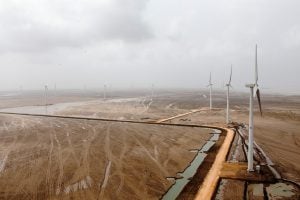Long before it became “fashionable”, Mexican economist Enrique Dussel Peters began researching China’s trade and investment relationship with Latin America, finding a substantial body of work dating back some 30 years previously.
Today, however, new observers are drawn to the subject in part by political elites’ grandiose declarations of South-South partnerships backed by growing trade and huge finance packages. But media, academics and politicians are encouraged to look at existing analyses of the drivers and actors behind the numbers, and by doing so, can help avoid costly misunderstandings, Dussel Peters has told Diálogo Chino in an interview.
For Dussel Peters, who coordinates the Latin America-China Academic Network (RED ALC-China) from the National Autonomous University of Mexico (UNAM), understanding the makeup of China’s unique public sector is critical. And not just for those Mexican businesspeople and politicians left scratching their heads as to why three major infrastructure deals backed by Chinese, including the infamous Mexico City-Querétaro bullet train, have fallen through in recent years. Other Latin American institutions underfunding research into China or approaching it from the study of manifold Asia-Latin America relations, would do well to look beyond grand – and unhelpful – narratives.
Dussel Peters spoke to Diálogo Chino about the costs of not understanding the nexus of public sector relations within China, its environmental footprint in Mexico, and why its unrivalled competitiveness in international trade is akin to the footballing superiority of FC Barcelona.
Diálogo Chino [DC]: You’ve been looking at China-Latin America relations for nearly 20 years. The subject is becoming increasingly popular, but there are many misconceptions. What’s the biggest mistake people make when looking at this topic?
Enrique Dussel Peters [EDP]: First, you don’t have to reinvent the wheel. People in China and Latin America have been looking at this for 40 years, in Mexico, in Brazil, Argentina, Peru you will find work on his topic and also in China. You simply have to start reading what the respective analyses resulted in. That’s one. And the second one, I would humbly say, is a romanticism regarding the Latin America and China relationship. Yes, this is a South-South relationship and you would somehow expect that, for whatever reason, it should be different from the US- or European-Latin America relationship. I would say China is not the South, China is not the North, China has conditions, structures from the South and from the North. I would simply quote our Chinese friends and say: “We have Chinese characteristics and we are different”. Packaging China in terms of South relationships is simply not useful. I would also say – note the irony and the criticism – when it’s useful for China to be part of the G77, they are an underdeveloped country. When it is useful for them, they are part of the G20, the G8, the G5 and even the G2. What China is in 2016 requires a lot of work and a lot of understanding. And if you think it is [explained by] one more indicator in the World Bank’s list of 600 world development indicators, then you are lost.
DC: How useful do you think the triangular China-Latin America-US approach is and how will it be affected by the election of Donald Trump?
EDP: I completely agree with this perspective. In our network we have been discussing this new – and it’s not only economic but political and cultural – triangle, not only in the US-Mexico-China relationship but also in relationship between US-Japan-China and others. The increasing presence of China is deeply questioning historical bilateral ties. A fantastic element in Trump’s protectionist argument is that the declining share of US exports to Latin America between 2001 and 2014 has meant the loss of 840,000 jobs annually for the US. But nobody cared about it. They were more concerned about the 10 guns China was giving to Venezuela. It’s a very critical topic that you cannot analyse from a simplistic perspective. In the US you have very strong forces. We’ve already witnessed Trump’s criticism of Ford, for example, but you have thousands of other firms participating in this triangular relationship. You can’t tell Ford that starting from tomorrow it can’t invest outside of the US, remembering that since the Second World War the US has been the main exporter of capital worldwide. You can’t end this in a week. If you want to impose tariffs of 45% in the US, you will have to pay substantially higher prices for consumer good in the US. Welcome to an interesting discussion…
DC: China’s rapid growth has created an environmental crisis with polluted air, water and soil incurring big economic and social costs. How well understood is this as a driver of its growing economic engagement overseas?
EDP: I sincerely believe that this is one of the drivers of China’s outbound foreign direct investment, trade and infrastructure but it’s not the only one. There are also macroeconomic factors – huge reserves that they invest in US bonds or in Latin America, hoping to get a high return. But there is also the acquisition of technology or research and development, such as Lenovo or automobiles and buying patents, for example. There are very aggressive upgrading policies, so it’s not just environment. The environmental issues involve transferring the footprint to other parts [of the world], there’s no question on that. But I would highlight that China, contrary to Japan, the US and other countries is extremely pragmatic. Chinese public firms can be very different investing in Japan or in Mexico. It’s not that they by definition implement low standards, they are very well able to implement very high or very low standards. That depends on the host country. Transnational corporations in Japan, the US and Germany know that it can be very expensive not having intra-firm standards, and they apply them. If you have a scandal in Zambia, then that will cost you more than the 10 cents you are saving in Zambia.
DC: In Mexico three big infrastructure projects have been cancelled. Was a lack of understanding of China in your country a factor in these cancelled projects?
EDP: Yes of course. I don’t think that Mexico’s public and private sectors have a sufficient understanding of China’s public sector and its implications – not only Mexico, but also Brazil and Argentina and many other countries. So the cancellation of one infrastructure project results in an overall freeze of the bilateral relationship. And then, from the Mexican side, they’re surprised. How is it possible they did not foresee this? China Railway Construction Cooperation is a public firm. As a matter of fact it’s a state-owned enterprise of the central government. Cancelling a project that is part of China’s belt and road strategy has immediate effects at all levels. It’s no surprise.
DC: With the Dragon Mart retail complex there was an environmental element. Lawyers argued it would damage sensitive ecosystems…
EDP: I believe there may be a strong environmental element but I’m no engineer or specialist. What I can assure you of is that is if this was a German, Swiss or UK project, then it would have gone through. I know the region in Cancún – Tulum – it’s a lovely place. But Spanish and European tourist firms have destroyed the region. They blew-up coral reefs and nobody cared. There are NGOs working on this case and it’s important to acknowledge their work, but in this case it was clearly anti-Chinese sentiment – and it was not even a Chinese investment. If you look at the proposal, and we have it uploaded on our website, the project is 90% Mexican capital and 10% Chinese capital.
DC: Where does this sentiment come from?
EDP: This generalised anti-Chinese sentiment is ignorance and the source is a lack of investing in public, private and academic institutions. Despite this massive dynamism in trade and investment and infrastructure projects, business organisations, the public sector, these institutions are very limited. They have Latin America-Asia institutes, and I’m very critical of that. Latin America and the Caribbean has 42 countries, Asia has 30 countries, 30 multiplied by 40 gives you 1200, then by five topics gives you 6000 to be discussed. And you only have two people in charge of the institute. That’s a joke. So you have ignorance, a lack of investment and, to be honest, you have racism.
DC: Many in China see Mexico as a competitor for the share of exports going to the US market – how does that affect the relationship?
EDF: Fifty years ago there was some competition in segments of value-added chains between Mexico and China. Textiles, electronics and auto parts, but this has passed. They are in different leagues. To give you an example, in yarn, textiles and garment exports to the US, China has a share of 40%. For Mexico, it’s 5%. There is no competition. 15 years ago it was 10% to 10%. Within this you have nylon socks and silk socks, they are different. Someone who doesn’t know would say: “socks are socks”. But you have different production lines, different machinery. They don’t have anything to do with each other. It’s a similar as a bicycle to a car. You might say: “they are both good for transportation”, but it’s like Zacatepec, a second-tier football team from Mexico, playing against Barcelona. If they lose 15-0, they’ve done very well. This is the game today.







